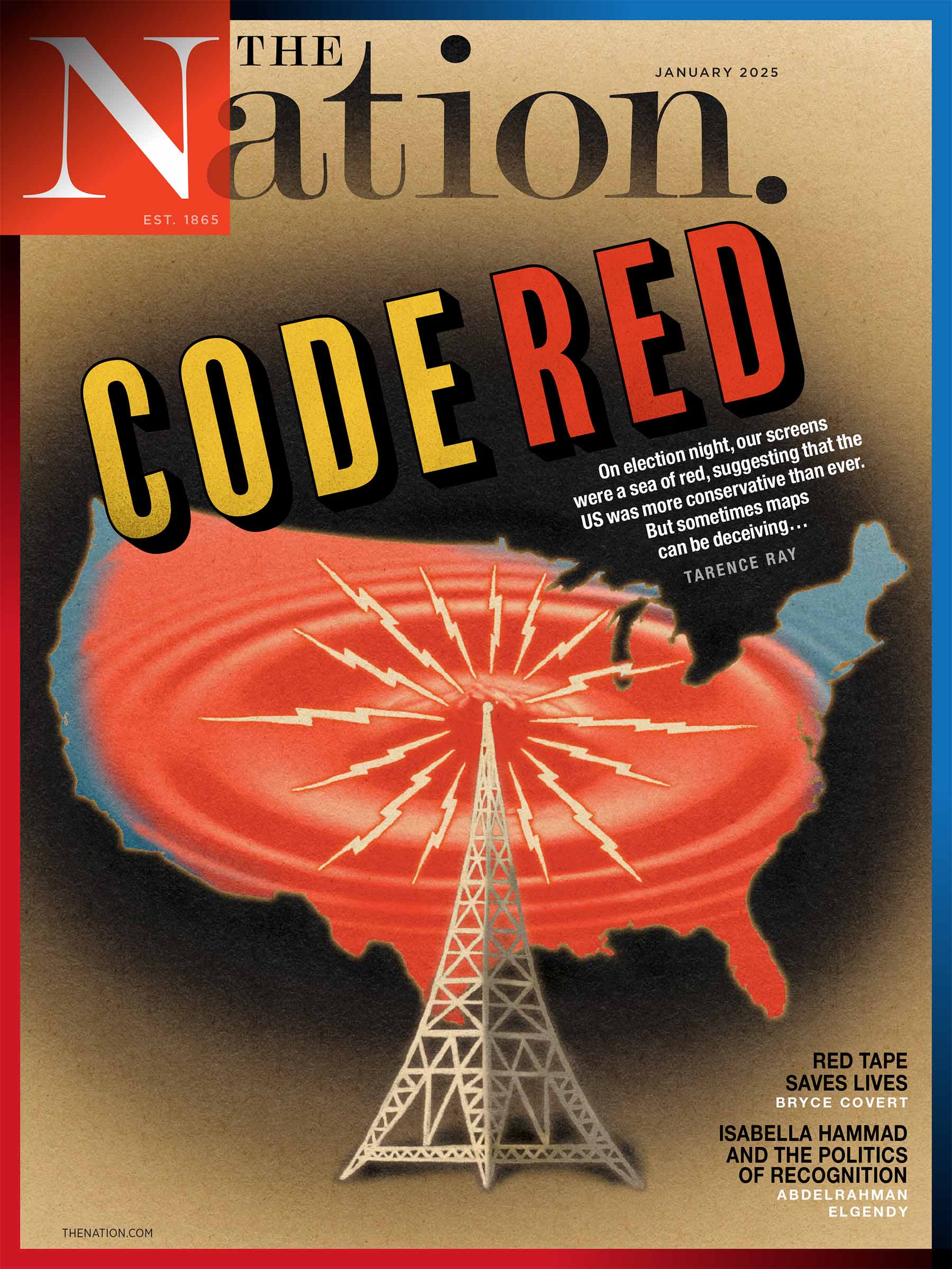Prochoice Generation Gap?
Port Chester, N.Y.
In 1996 ten of the country's leading prochoice organizations collaborated to overcome many of the obstacles noted in Jennifer Baumgardner's March 5 "The Pro-choice PR Problem" by forming The Pro-Choice Public Education Project. PEP strives to energize younger women and develop the next generation of leaders.
What Baumgardner seems to be missing is that PEP is an effort to "engage young women more directly in the struggle for abortion rights." As local organizations work to build their forces, challenge antichoice initiatives and raise awareness, PEP provides tools that would be too expensive for these groups to produce on their own. PEP conducts cutting-edge research on the opinions of young women, commissions ads that can compete for the attention of young women and throughout the country introduces these findings and ads to groups through workshops. Groups in forty states have used PEP's ads and research to involve and educate young women about threats to their reproductive rights. Please visit our website at www.protectchoice.org.
THE PEP STEERING COMMITTEE
New York City
Having arranged the Open Society Institute's research support for Jennifer Baumgardner's article, I now take issue with her findings. Baumgardner is correct that the prochoice movement has faced a difficult dilemma in mobilizing young Americans who support, but are complacent about, reproductive rights. She sets up a false dichotomy, however, between efforts to engage young people through advertising and conventional grassroots organizing. In virtually all of the examples she cites the two have gone hand in hand.
Baumgardner portrays The Pro-Choice Public Education Project, a collaborative effort of ten prochoice organizations, as a prizewinning advertising campaign disconnected from the grassroots. This simply ignores ample evidence that was provided her. Groups in forty states--including local affiliates of Planned Parenthood, NARAL and The Feminist Majority Foundation--all of which work with large numbers of young people, have been using the ads at no cost to educate and inspire activism. Follow-up polling after paid placement of the ads in subways in New York and San Francisco also demonstrated considerable impact. In addition, those ads drove extensive free media coverage in magazines and newspapers across the country, which dramatically increased the value of a relatively modest investment in their production and placement.
Baumgardner, on the other hand, extols the virtues of Choice USA, a spirited organization of young women inspired by Gloria Steinem, which works primarily on college campuses. Not mentioned is the fact that Choice USA has also employed its own paid ads in college newspapers to great effect--ads featuring wholesome young women claiming the right to make responsible choices.
Most curious is Baumgardner's claim that investment in advertising to reframe the prochoice debate has had no political impact. Nothing could be further from the truth. At least three major exit polls last November revealed that choice had registered as a surprisingly strong concern among voters, just behind education and Social Security, and ahead of taxes.
Much has been made of the large numbers of women who deserted George W. Bush, despite his deliberate efforts to obfuscate onthe abortion issue and to buy silence from the Republican Party's right wing. Several of Al Gore's advisers have admitted their mistake in failing to speak more forcefully about Bush's poor record on reproductive rights. They've given credit for moving the issue up on the radar screen--and for driving up Gore's numbers in key states like Wisconsin and Oregon--to targeted media campaigns by NARAL and Planned Parenthood. If only there had been more of them.
These campaigns also had strong grassroots components, which are producing an important dividend as George Bush now shows his true stripes, arousing all of us, old and young alike, from our complacency. In the Ashcroft confirmation hearings, Planned Parenthood and NARAL mobilized a rapid response. Thousands of letters, e-mails and phone calls from irate citizens finally awakened Senate Democrats to the new political resonance of reproductive rights. Now, prochoice Republicans in both houses say they are prepared to reject Bush's reinstatement of the global gag rule, which compromises rights of free speech and of privacy for countless women around the world. One could argue that media and message development has rarely seen such successful outcomes. And now is certainly no time to quiet down about what's at stake.
ELLEN CHESLER
Program on Reproductive Health and Rights
The Open Society Institute
Amherst, Mass.
I have a different opinion about the "pro-choice PR problem." I was a young prochoice activist in the late 1980s-early 1990s, when there were thousands of women, born before Roe v. Wade but just barely, who viewed abortion rights as a cause they were willing to fight hard for. None of us were old enough to remember when abortion was illegal, but we devoted our weekends to clinic defense and spent evenings volunteering in the NARAL office.
What happened? I don't think it was apathy. First, the increase in violence in the movement (shootings, bomb threats, etc.) combined with a sense that there was no protection from police or government was enough to scare some folks away from the frontlines.
Second, with the election of Clinton some believed they could rely on Democratic promises to safeguard choice (most of us were too young to remember anything but Republican rule). Little did we know that the number of abortion providers would fall at an even more rapid pace in Clinton's first term than over the decade that preceded it.
Finally, it was exactly the PR approach to abortion that led to a very real disillusionment with national groups like NARAL. All too often NARAL lived up to its single-issue reputation, ready to risk gains in other areas of women's rights for the sake of abortion alone. Yes, that's expected--the name alone implies it. But compare NARAL with the grassroots groups (like the DC Coalition for Choice, in NARAL's own backyard) that saw abortion as a key demand but only one in the broader struggle for women's rights. Baumgardner's article highlights this by pointing out how NARAL spent $1.5 million on ads attacking Ralph Nader, ignoring a raft of other women's issues in the 2000 presidential campaign (e.g., welfare "reform," free trade, labor rights, universal healthcare). NARAL's slick fundraising, lobbying and inside-the-Beltway approach--represented so clearly in its anti-Nader attack--alienated the young women who wanted to fight for choice inside a larger movement for social justice.
I hope that new groups like those started by Choice USA will revitalize that kind of grassroots feminist movement.
STEPHANIE LUCE
Grand Rapids, Mich.
I'm a progressive prolifer, 29, female and a full-time worker. There are many young, activist (not even Catholic--imagine that!) females like myself who are working to eradicate the need for abortion but doing so without the stereotypical "aborted fetus" imagery. We also have an amazing ad agency, filled with industry awards, dishing out amazing ads geared toward supporting women. I know, you'd have to see them to believe it. They are the voice of a new generation of prolife women, and they are nonjudgmental, nonviolent, nonauthoritarian. We too, had a series of ads that were rejected by the networks because they were too controversial, and they contained no offensive imagery whatsoever.
AMANDA PETERMAN
Right to Life of Michigan Educational Fund
New York City
One problem is obvious: Where does the coalition of fifty women's rights organizations have its "prizewinning New York advertising agency" target our limited liberal dollars? "Subways and buses throughout the city"! Except for a small percentage on the E train to Queens and some local buses in some neighborhoods, who will they influence in a city and state with every serious candidate running, to some degree, on a prochoice ticket?
ALAN SAGNER
Hudson, N.Y.
For years the prochoice community has been "reactive" to the antichoice community on issues ranging from clinic safety to late abortions. Planned Parenthood has made some attempts to reframe the "discussion" in terms of promoting family health and stability by maintaining access to affordable abortions and family planning methods. However, in my private practice where I provide medical abortions (Mifeprex) to middle-class women in New York City, I find they have little interest in supporting prochoice organizations or any real concern that their hard-fought right of "choice" could disappear with loss of one or two Supreme Court heartbeats.
Conservative members of the House and Senate are gathering to try to find ways of restricting the use of Mifeprex ("the abortion pill") or even withdrawing FDA approval. These threats are real and the danger posed to women's reproductive health equally real. Furthermore, Mifepristone may have important uses in the treatment of breast, ovarian and uterine cancers. In the words of Eminem, "Please stand up."
RICHARD HAUSKNECHT, MD
The Mount Sinai School of Medicine
Scituate, R.I.
Jennifer Baumgardner advocates efforts to engage young women in the struggle. My experience suggests that young men can be targeted too. Hearing Molly Yard of NOW speak, and other campus activism, helped propel me to take part in clinic defenses, marches on DC and years of NARAL donations.
ELIOT LEVINE
BAUMGARDNER REPLIES
New York City
As I made clear in my article, the ads Devito/
Verdi created for PEP are truly great. However, these great ads don't have broad or effective distribution except in San Francisco and New York City, two cities with excellent access to abortion (as Alan Sagner points out). In other words, the ads won't fulfill PEP's stated mission "to energize younger women and develop the next generation of leaders." Especially when they can't even get the ads on the air.
The antichoice groups have had better luck getting their ads shown. Therefore, I have to disagree with Amanda Peterman of Michigan Right to Life when she asserts that her side is the victim of network squeamishness, too. Their antichoice ads were pulled not for being controversial but because they made false claims about then-Representative (now Senator) Debbie Stabenow's voting record on late-term abortions. (The ads claimed Stabenow voted against banning the procedure. Sadly, Stabenow stated that she "has repeatedly supported legislation to ban all late-term abortions...unless a doctor says that the health or life of the mother is in serious danger.")
I agree with Ellen Chesler that the members of PEP believe in both grassroots organizing and advertising. But the PEP project has accomplished primarily the glitzy-ads part of the equation at the expense of efforts to build consciousness (and recruit young activists) through painstaking person-to-person organizing. Further, there is ample evidence that the "grassroots" (i.e., younger women--the majority of those who have abortions) are not really listened to by this prochoice establishment. A 24-year-old PEP fellow named Rebecca Gurney, for instance, initiated several projects to increase the connection between PEP and younger women (the presumed-ignorant target audience of the ads). She developed a mentoring network, among other projects, but none of her suggestions were taken. Amy Richards, who helps administer an abortion fund for young women via Third Wave Foundation, wrote a letter encouraging PEP to include young women in their leadership and strategy-building in 1996, at PEP's inception. Richards received no response. (Third Wave is listed cosmetically as part of the PEP coalition, but it has no decision-making power.)
I wrote my article before Bush became President, and I almost pulled it because it felt odd to criticize some of the most important organizations providing and preserving abortion rights now that these rights are threatened more than ever. My decision not to was vindicated by the letters in response. They reveal PEP's delusion that a New York- and San Francisco-oriented ad campaign with virtually no input by younger women or men is an effective way to reach those people and ignite the prochoice majority. If anything, the ads worked to take votes from Nader (which, as Stephanie Luce points out, alienated some lefty female voters). Bush, on the other hand, received 49 percent of the white female vote. While researching the strategies and makeup of the entrenched prochoice groups and PEP, I discovered that some constructive criticism about the efficacy of this expensive undertaking was in order. I think there's a place for thoughtful critique within the movement, and I offer my article in that spirit. I do believe that we can maximize a prochoice majority, and I support ongoing efforts to do so.
JENNIFER BAUMGARDNER
Read More
Our Readers







